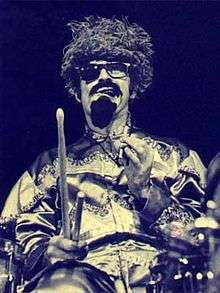Ron Sweed
| Ron Sweed | |
|---|---|
 | |
| Born |
Ron Sweed 1950 Cleveland, Ohio, U.S. |
| Occupation |
TV movie host Radio disc jockey Comedian Author |
| Years active | 1971–present |
| Website | The Ghoul.com |
Ron Sweed, (born 1950, Cleveland, Ohio), is an American entertainer and author known for his late-night television horror host character The Ghoul.
Early Life and career
In 1963, 13-year-old Sweed wore a gorilla suit to a live appearance by Ghoulardi, a popular Cleveland television personality played by Ernie Anderson on WJW-TV. Ghoulardi took note of the costume and brought Sweed on stage, and over the next few weeks, Sweed became Anderson's production assistant.
After Anderson left Cleveland for Los Angeles in 1966, Sweed left for Bowling Green State University, but continued to help with the production of the Hoolihan and Big Chuck show, which was Ghoulardi's replacement on WJW.[1]
The Ghoul
Sweed took "The Ghoul" to Kaiser Broadcasting station WKBD-TV in 1971. Though it started as a tribute to Ghoulardi, Sweed soon developed his own eye-catching gags and energetic style. Known for his zany, early-adolescent humor (particularly surrounding his abuse of a rubber frog named "Froggy," his well-known penchant for blowing up model ships and aircraft with firecrackers, and his habitual smearing of Cheez Whiz over everything in sight), late night monster movies were a unique experience for Cleveland viewers in the 1970s.[2]
The Ghoul would typically take an unbelievably bad horror movie and dump in sound bites at appropriate moments, using audio clips from novelty records, George Carlin, Firesign Theater and rock albums of the 60's and early 70's. And whenever a character took a drink of something on-screen, The Ghoul would supply a good, loud belch.[3]
Kaiser Broadcasting soon syndicated The Ghoul Show to Detroit, Chicago, Boston, Philadelphia, San Francisco and Los Angeles. It bombed in Chicago (where Sweed had the thankless task of replacing the popular Svengoolie) and in Boston, but was huge in Detroit at WKBD TV-50, and enjoyed varying degrees of success in the other markets. Despite the show's popularity, Kaiser eventually canceled it in 1975 amid complaints from parents about the content of some of Sweed's skits, as well as the permanent closure of WKBF by Kaiser itself. But The Ghoul resurfaced in 1976 on independent Detroit station WXON TV-20, and on WKBF's successor station, WCLQ TV-61.[2]
Sweed has since been on and off the air in Cleveland and Detroit for over three decades, at times even branching out into radio. The Ghoul returned to Cleveland TV in 1998 on WBNX-TV Channel 55 (the then WB affiliate—now CW) where he remained for the next six years airing on Friday, then later Sunday nights. He also did a Saturday night request show on WNCX FM 98.5 during the same time period.[1]
The same year, Sweed co-authored (with Mike Olszewski) The Ghoul (S)crapbook (ISBN 1-886228-22-1), a book collecting memories, on-set photographs, transcripts, correspondence, and memos from his years on the air.
Influence
The Ghoul is still well known enough in the Cleveland and Detroit markets that some of his catch phrases ("Overdey!", "Hey group!", "Scratch glass, turn blue", "Stay sick, climb walls", "Pluck your magic twanger, Froggy!", "Holy Parma", "Amrap" and Froggy's "Hiya gang, hiya hiya hiya!") are still widely recognized among the children of the 1970s.[3]
Lawsuit
Sweed sued Keven Scarpino, a.k.a. the Son of Ghoul, in 1987 for infringing upon The Ghoul's character, but eventually lost the case. The judge ruled that no infringement occurred, as most horror show hosts portrayed the same basic character, a ghoulish individual who pranced about in costume, performed comedy routines, and showed horror movies.[4]
References
Further reading
Feran, Tom; Heldenfels, Rich (1999) Ghoulardi: Inside Cleveland TV's Wildest Ride. Cleveland, OH: Gray & Company, Publishers. ISBN 978-1-886228-18-4
External links
- TheGhoul.com - Official Site
- TheGhoul.net - Subscription website
- HorrorHosts.com
|